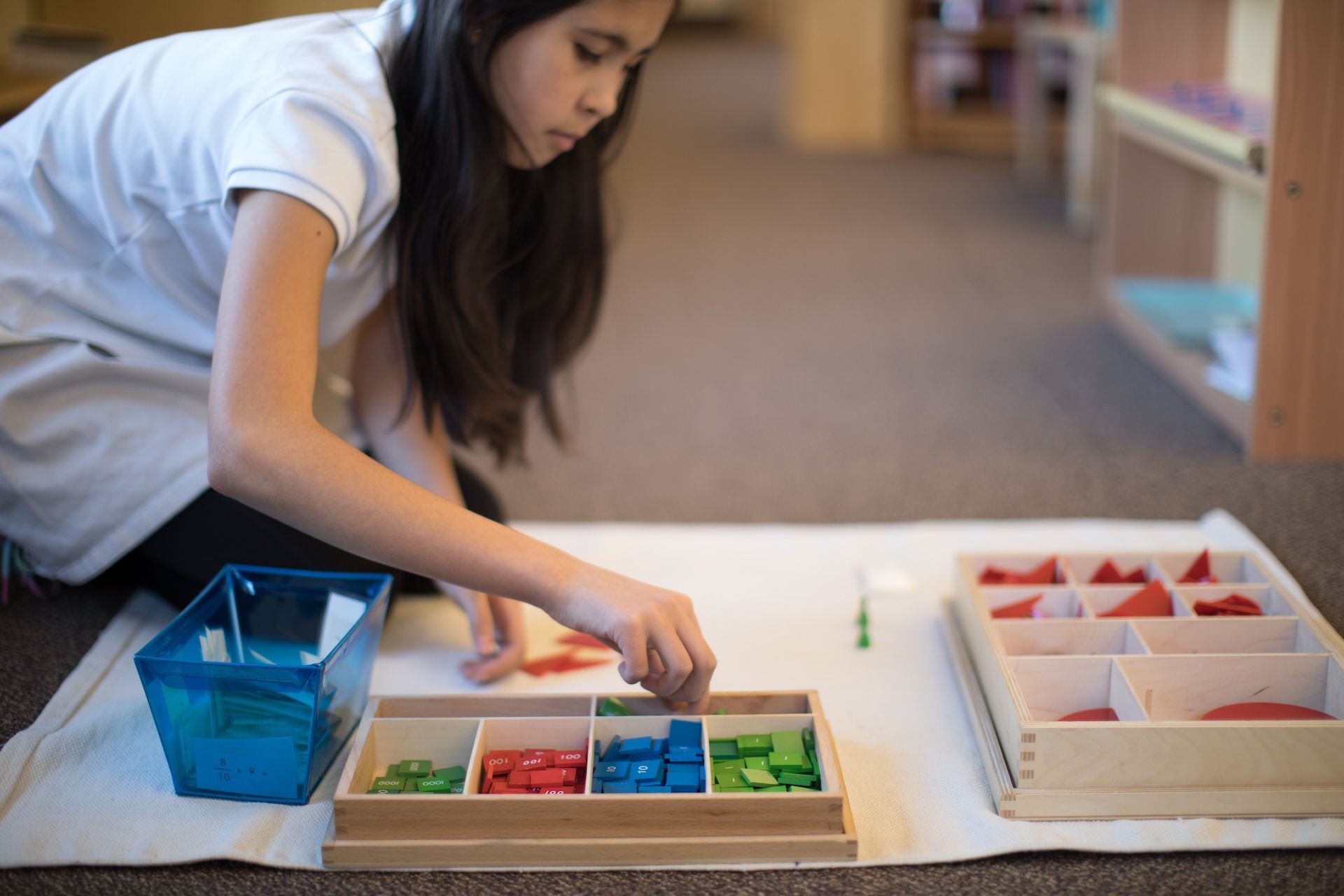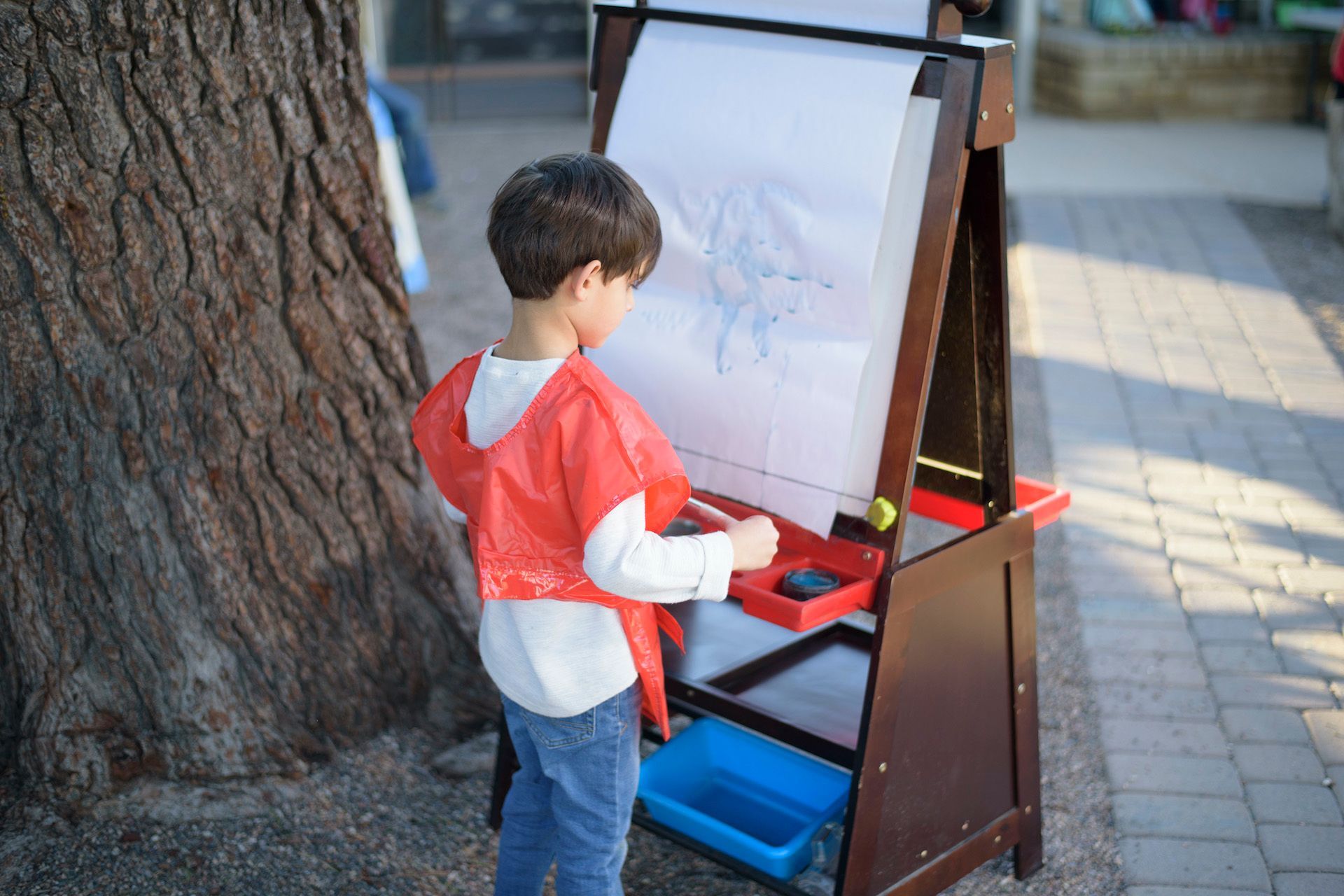


Numerous theories and lots of research expound upon the importance of artistic expression. For young children and adolescents, art is an especially crucial form of personal expression. As such, children need to experience their own process rather than to produce a piece that someone else wants. In Montessori, we also have sensitivity to different expressive needs throughout different stages ofdevelopment.
For young children,the process of making art is much more important than the product. When infants and toddlers are engaged in art activities, they are expressing feelings that they may not yet have words to express. Thus, during these early years, we focus on offering young children a variety of different artistic mediums.
When children are using different art materials, we first provide opportunities to work with larger spaces and then later move into the smaller more refined possibilities. For example, we start with painting at the easel, then as children develop more coordinated hand movements, we offer smaller paper or objects to paint.
In addition to introducing different kinds of materials, we also show young children how touse different tools. We show how to use just a little water and the tip of the brush with watercolor paints. We explore different techniques with crayons. We introduce various tools–like knitting needles, crochet hooks, or looms–for fiber arts. Whatever the form of art, we offer the tools required for successful expression through that form.
We also open up a range of possibilities for children to explore. For example, in introducing clay, we show how to carefully get out the clay, how to use different techniques such as forming coils and slabs, how to cut, carve, or roll the clay, and how to store it when finished. We may also show examples of clay sculptures, whether in books or museums. With all of this information, children have a range of inspiration when they decide to work with clay.
To support young children’s artistic expression, we offer objective comments: “Oh how interesting…the lines go up and down,” or “I can see you used a lot of red and blue paint today.” We want to be very careful with what we say so we don’t give any indication of judgment, either good or bad. Young children do not yet have the language to explain their art. Therefore, we want to make sure our comments don’t inadvertently create expectations for children.
In Montessori, adults don’t insist that children express themselves artistically, or tell children what to express. When children choose some form of artistic expression, adults allow them the freedom to be with themselves while in the process of creating art. With this in mind, children’s artwork is individual, creative, non-competitive, and often connected to other subjects. We don’t expect children to learn to imitate adult creations or turn out products that all look alike.
From six to twelve, children began to use art in a more cognitive way. Often elementary-aged children began to want their artwork to be very realistic. They may focus moreon the finer details of a particular piece of art rather than on the overall composition. As a result, children of this age can become discouraged if they feel their art “doesn’t look right.” Their determination is relentless. Because they will often insist upon realism, even at the risk of giving up on their artistic ability, we offer many different sub-skills to help children refine their techniques.
Art in a Montessori elementary classroom is often connected to students' intellectual pursuits. When studying Ancient Egypt, students may want to create a portrait in profile or a model of a pyramid. If they are immersed in learning about a country, they might learn about the symbolism of the flag’s colors and sew a sample flag.
All of this work is aided by the fact that children of this age love big projects. To support their artistic and intellectual pursuits, we provide elementary students with a kind of mini-studio so they can access the materials they need to create big projects and share their learning with their peers.
During adolescence, young people need even more opportunities to form, shape, express, and clarify their inner thoughts, feelings, and experiences. Artistic expression can be a vital outlet during this turbulent time, and can allow adolescents to not only reach a better understanding of who they are but also to be able to connect deeply with others through shared expression.
Questions of identity and fitting in weigh heavily on adolescents. Without ample opportunities for expression, these already perplexing questions can fester. Adolescents need creative outlets to keep their spirits vibrant!
In addition, expressive opportunities allow adolescents to merge their emotions with their intellect. It’s best to have a variety of avenues for artistic expression: instruments readily available to pick up, an art studio to transfer complex feelings into visual art, or opportunities for dramatic interpretation of academic content.
In Montessori, we feel strongly that young people need artistic outlets so they can have balance in their physical, emotional, social, intellectual, spiritual, and creative development. A Montessori environment supports the development of the whole person, thus allowing children to explore their personal creativity.
Art is a vital form ofexpression throughout different stages of growth. Through art children can express what they are feeling, elementary-age students can integrate their learning and refine their skills, and adolescents can better understand themselves and their connections to others. Creating art can allow our young people to reveal feelings that they could perhaps not express in words. Thus,we offer children a variety of art mediums and different experiences, as well as the freedom to choose and experience the form they have chosen.
As always, we inviteyou to come to visit our school to see this artistic expression in action!


We invite you to visit our school, meet the teachers, and observe the children in their classrooms. We encourage you to ask questions and learn about the opportunities available at all levels of our programs.
LakeCreek Montessori International School
10127 Lake Creek Parkway, Austin, Texas, 78729
Powered by Nido Marketing